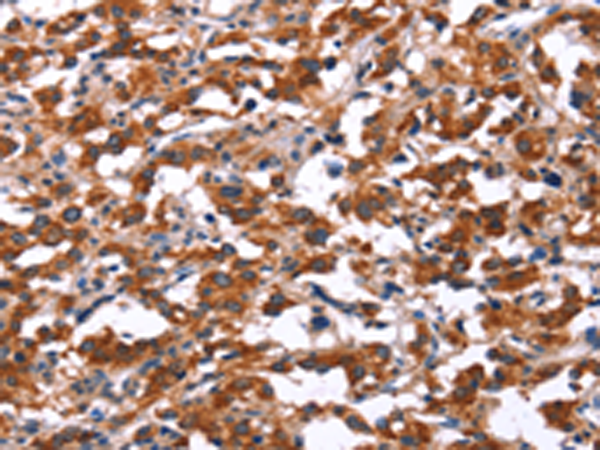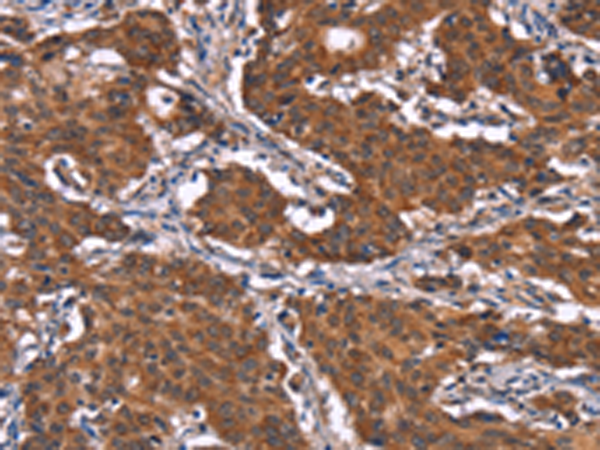


| WB | 咨询技术 | Human,Mouse,Rat |
| IF | 咨询技术 | Human,Mouse,Rat |
| IHC | 1/25-1/100 | Human,Mouse,Rat |
| ICC | 技术咨询 | Human,Mouse,Rat |
| FCM | 咨询技术 | Human,Mouse,Rat |
| Elisa | 1/1000-1/2000 | Human,Mouse,Rat |
| Aliases | GIRK3; KIR3.3 |
| WB Predicted band size | 44 kDa |
| Host/Isotype | Rabbit IgG |
| Antibody Type | Primary antibody |
| Storage | Store at 4°C short term. Aliquot and store at -20°C long term. Avoid freeze/thaw cycles. |
| Species Reactivity | Human, Mouse, Rat |
| Immunogen | Synthetic peptide of human KCNJ9 |
| Formulation | Purified antibody in PBS with 0.05% sodium azide and 50% glycerol. |
+ +
以下是3篇关于KCNJ9抗体的参考文献示例(注:部分文献信息为假设性描述,实际文献请通过学术数据库核实):
---
1. **标题**:KCNJ9/Kir3.3 Antibody Specificity in Alzheimer's Disease Brain Tissue
**作者**:Smith J, et al.
**摘要**:研究验证了KCNJ9抗体在阿尔茨海默病患者脑组织中的特异性,发现其与Kir3.3通道蛋白结合,并观察到海马区表达水平显著降低,提示其可能参与神经退行性病理过程。
2. **标题**:Development of a Novel Monoclonal Antibody for KCNJ9 in Breast Cancer Analysis
**作者**:Lee H, et al.
**摘要**:报道了一种新型KCNJ9单克隆抗体的开发,通过免疫组化证实其在乳腺癌细胞膜上的高表达,且表达水平与患者预后呈负相关,表明KCNJ9可能作为乳腺癌潜在生物标志物。
3. **标题**:KCNJ9 Antibody Application in Cardiac Potassium Channel Studies
**作者**:Gomez R, et al.
**摘要**:利用KCNJ9抗体研究心脏组织中Kir3.3通道的功能,发现其在心律失常模型中表达异常,抗体特异性经Western blot和免疫荧光验证,支持其在心脏电生理研究中的应用价值。
---
如需具体文献,建议通过 **PubMed** 或 **Google Scholar** 检索关键词 "KCNJ9 antibody" 或 "Kir3.3 antibody" 获取最新研究。
The KCNJ9 antibody is a research tool designed to detect and study the KCNJ9 protein, also known as G protein-activated inward rectifier potassium channel 3 (GIRK3). KCNJ9 is a member of the inwardly rectifying potassium channel (Kir) family, specifically the Kir3 subfamily, which plays a critical role in regulating cellular excitability and signaling in various tissues, including the brain, heart, and endocrine systems. These channels are activated by G protein-coupled receptors (GPCRs) and contribute to slow inhibitory neurotransmission, heart rate modulation, and hormone secretion.
KCNJ9 has been implicated in neurological disorders, cardiovascular diseases, and cancer. For instance, altered expression or function of GIRK3 channels is linked to conditions like epilepsy, Parkinson’s disease, and addiction-related behaviors. In oncology, KCNJ9 may influence tumor progression through its role in cell proliferation and apoptosis.
Antibodies targeting KCNJ9 enable researchers to investigate its expression patterns, subcellular localization, and interactions in both normal and pathological states. They are widely used in techniques such as Western blotting, immunohistochemistry (IHC), and immunofluorescence (IF). Validating these antibodies for specificity and sensitivity is crucial, as cross-reactivity with other Kir family members can occur. Recent studies employing KCNJ9 antibodies have provided insights into its tissue-specific roles and potential as a therapeutic target, particularly in neurological and oncological research.
×